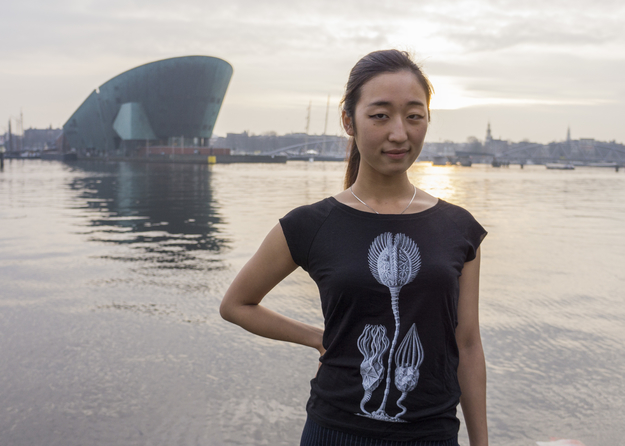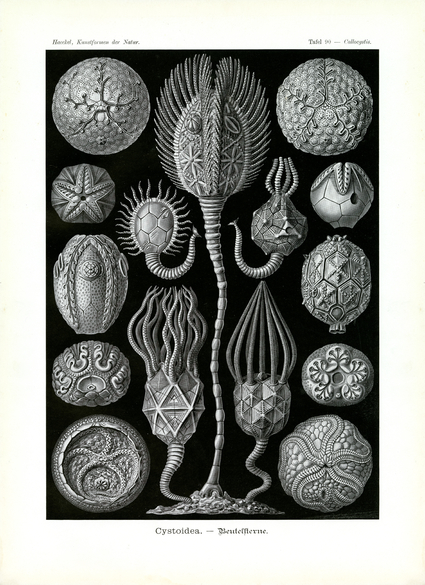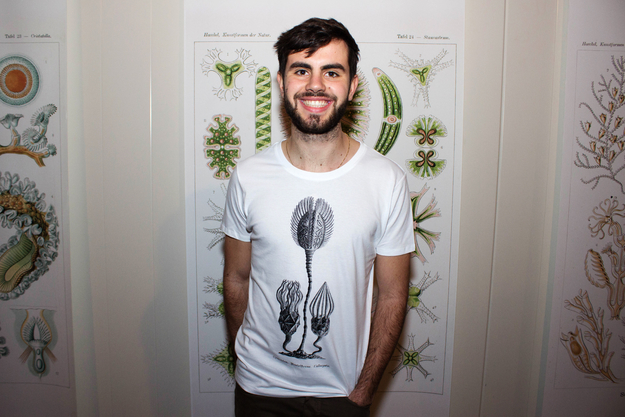Plate information
The class of ‘pouch-star’ or ‘sea-apple’ (Cystoidea) lived during the Palaeozoic Age only, millions of years ago; we, therefore, know only petrified remnants of these ‘star-animals’ that became extinct long ago (just like in ‘case-stars’, plate 95, and in ‘bud-stars’, plate 80). Just like these two Cystoidea lived a sessile life, fixed to the ocean floor with the help of an articulate stalk. The pouch-shaped, almost globose body is armoured with strong lime panels, usually showing three openings. The upper opening (opposite to the stalk) rests centrally as the mouth, the other two openings are positioned eccentrically on each side. The bigger, lower one is the anus-opening (in most cases pyramid-shaped, closed with 5-6 flaps); the smaller opening, in between mouth and anus, is the ‘sexual opening’ (Gonoporus). The mouth of the ‘pouch-stars’ is surrounded by a ‘sensing-rosette’ or Ambulacral-rosette (Anthodium) that is usually composed of five band-shaped or leaf-shaped radiants (Ambulacra); in more rare cases only four are present (fig. 1), three (fig. 9) or two (fig. 6). Each ‘sensing-plane’ or Ambulacrum consists of an exterior ‘supply groove’ (Subvector) and a corresponding part of the interior ‘water-line’ or Ambulacral-system, lying below. The centre of this water supply system is a ‘water container ring’ (Hydrocircus) that surrounds the mouth and takes in seawater from outside through an external opening, the ‘water-hole’ (Hydroporus, fig. 11). The ‘radiant-vessels’ or “Perridial-canals” (usually five) that advance from the ring canal, move radially along the shorter or longer line of the shell capsule (Theca); they provide small lateral branches to the flexible fingers that are in most cases structured in two rows along the ‘supply-grooves’, covered with small platelets. Food is supplied in the Subvectors through movements of the cilia towards the mouth. All Cystoidea, illustrated here in natural size or at low magnification, have been found in a petrified condition in the Silurian Mountain, most of them in Russia and North America.
T-Shirts
Our T-shirts are ECO-friendly silkscreened by Superette on biological Bamboo T-shirts.
We provide two different colours, black and white, and four different sizes; S, M, L, XL.
You can order them by emailing your design of choice (Cystoidea), colour and size to mail@mediamatic.nl.
We will inform you as soon as possible about the payment details. When the payment is completed you can pick the shirt up at Mediamatic Biotoop, Dijkspark 6 1019 BS Amsterdam.
Posters
It is also possible to get this print as a large scale poster.
You will find more details about our posters here.


